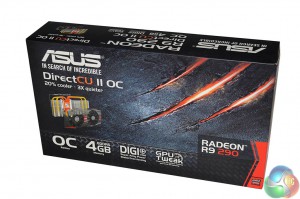
Asus seem to have been using this particular ‘red claw' box artwork forever. Along the bottom of the box are a list of key specifications and an image of the Direct CU II cooler.
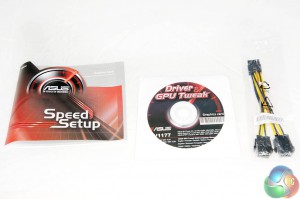
Not an extensive bundle inside – just a software disc, speed setup guide, and power converter cable.
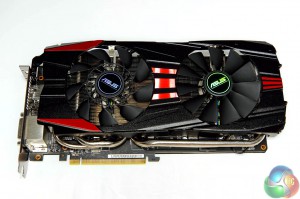
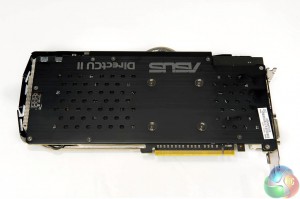
A very heavy card, thanks to the metal construction and backplate.
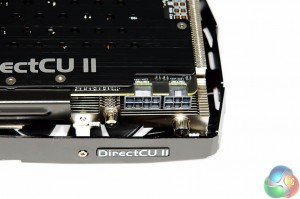
The Asus R9 290 Direct CU II OC takes power from a single 6 pin and 8 pin power connector. Same as the reference design.
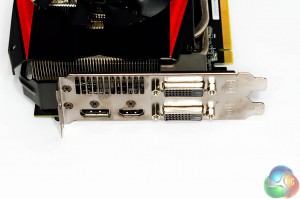
The card has a DVI-I, DVI-D, full sized HDMI and DisplayPort connectors.
R9 Series graphics cards can now support up to three HDMI/DVI displays for use with AMD Eyefinity technology. A set of displays which support identical timings is required to enable this feature. The display clocks and timing for this feature are configured at boot time.
As such, display hot‐plugging is not supported for the third HDMI/DVI connection. A reboot is required to enable three HDMI/DVI displays.
There is no Crossfire connector on the R9 290. The 290 and 290x offer Bridgeless Crossfire capabilities.
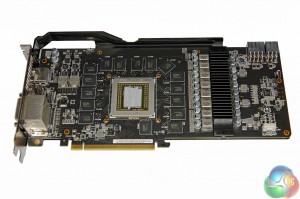
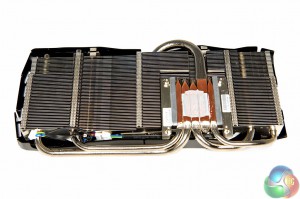
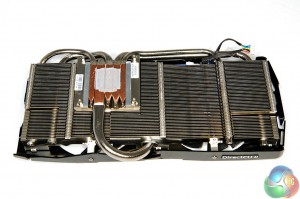
Above, the Asus R9 290 Direct CU II OC disassembled. Asus are using Elpida memory which some feel is lower grade than equivalent GDDR5 Hynix. Regardless of how you look at it, the memory on these cards is certified to run at the respective speeds and we haven't ran into any issues before during testing. We spoke with other AMD partners, and they told us that the 2013 Hynix fire has meant sourcing memory from other factories has been critical.
It has been brought to our attention by several readers that ASUS have transplanted this specific Direct CU II cooler from their GTX780 range of hardware. Asus have not confirmed this, however we can see by the thermal paste footprint in the images that while there are five direct touch copper heatpipes, only 3 of them are making direct contact with the AMD R9 GPU core. That said, the outer two heatpipes will be working a little via heat transference with the others.
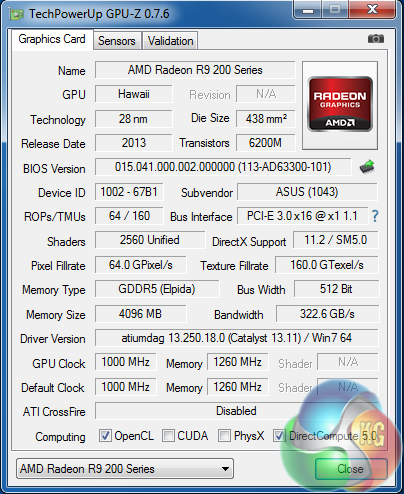
An overview of the Asus R9 290 Direct CU II OC, clocked at 1GHZ. The Hawaii GPU is built on the 28nm process and the card comprises 6.2 billion transistors. The R9 290 has 64 ROPS, 160 texture units and 2,560 Stream processors. The 4GB of GDDR5 memory runs at 1,260mhz (5.04Gbps effective) and is connected via a wide 512 bit memory interface.
 KitGuru KitGuru.net – Tech News | Hardware News | Hardware Reviews | IOS | Mobile | Gaming | Graphics Cards
KitGuru KitGuru.net – Tech News | Hardware News | Hardware Reviews | IOS | Mobile | Gaming | Graphics Cards


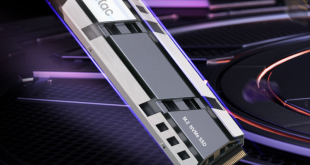
Why would they move the VRM sensor to a place that is going to report hot results? surely thats an engineer foobar?
Sapphire rule the AMD roost, because they always do a proper design – and they don’t make nvidia boards either.
I read this review as ASUS cut corners, and have a cooler which isn’t quite at the same level as their competitors. I love their motherboards, but wonder about some of their design decisions once they move to other products.
So the VRM temp sensor doesn’t actually reflect the VRM’s true temperature.
The Cooler itself doesn’t fully cover the gpu (3 of 5 pipes at best it looked like?)
And they are using poorer quality Elpida memory modules, which are well known to be a source of the black screen crashes on the 290 series cards, over the far more stable Hynix modules that sapphire/gigabyte/msi use?
And all of this comes at a serious price premium (£529.99 on ocuk atm vs £439.99 for the gigabyte and £449.99 for the msi versions, which both offer better hardware).
How is this an 8/10 card? Closer to 4/10 surely given the poor decisions made and the price point compared to rival cards.
Not sure where you are getting the prices from, its £389.99 http://www.overclockers.co.uk/showproduct.php?prodid=GX-334-AS&groupid=701&catid=56&subcat=1752.
Unless you are looking at the 290x cards and getting mixed up.
My bad, you’re right there.
Nevertheless, the rest stands for all versions of the 290’s, and it still sits at a ~10% price premium vs other cards of its type, while still having the same hardware flaws. It’s just more pronounced with the X version.